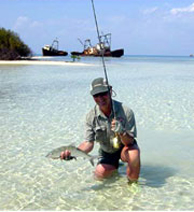Jardines de la Reina: Like in the First Day of Life
- Submitted by: admin
- Travel and Tourism
- 06 / 18 / 2010

The scientists affirm that today’s National Park Jardines de la Reina is the best preserved and richest in species of the four great marine reservoirs surrounding the Island, group that conforms the great Cuban archipelago.
About two thousand 170 square kilometers is the approximate extension of this surprisingly virgin group of keys and small islands, located to the south, from the central provinces of Ciego de Avila and Camaguey until the proximities of Granma province, in the eastern region.
It was baptized by admiral Christopher Columbus, honoring Isabel de Castilla, and it’s one of the only names chosen by him that survive in Cuba. The other one is that of Cabo Cruz (Cross Cape), according to history.
Most of the straits and small keys of Jardines de la Reina emerge at about 30 or 80 kilometers off the coasts, almost in the limits of the island platform.
The environment is rich in dense swamps, with roots deep in the salty waters, and in land there are complex of bushy vegetation, dunes and the typical coastal bushes.
Caballones, Anclitas, Cinco Balas, Caguamas, Breton, and Algodones are the names of the largest keys, where in turn a very populated fauna of insects, arachnids, reptiles live as well as the charismatic iguana and birds.
Although scarce, there are small beaches of white sand, still in formation, but ideals for a good swim.
About two thousand 170 square kilometers is the approximate extension of this surprisingly virgin group of keys and small islands, located to the south, from the central provinces of Ciego de Avila and Camaguey until the proximities of Granma province, in the eastern region.
It was baptized by admiral Christopher Columbus, honoring Isabel de Castilla, and it’s one of the only names chosen by him that survive in Cuba. The other one is that of Cabo Cruz (Cross Cape), according to history.
Most of the straits and small keys of Jardines de la Reina emerge at about 30 or 80 kilometers off the coasts, almost in the limits of the island platform.
The environment is rich in dense swamps, with roots deep in the salty waters, and in land there are complex of bushy vegetation, dunes and the typical coastal bushes.
Caballones, Anclitas, Cinco Balas, Caguamas, Breton, and Algodones are the names of the largest keys, where in turn a very populated fauna of insects, arachnids, reptiles live as well as the charismatic iguana and birds.
Although scarce, there are small beaches of white sand, still in formation, but ideals for a good swim.
By: Marta Gomez Ferral
Source: Cubasi Translation Staff
Comments